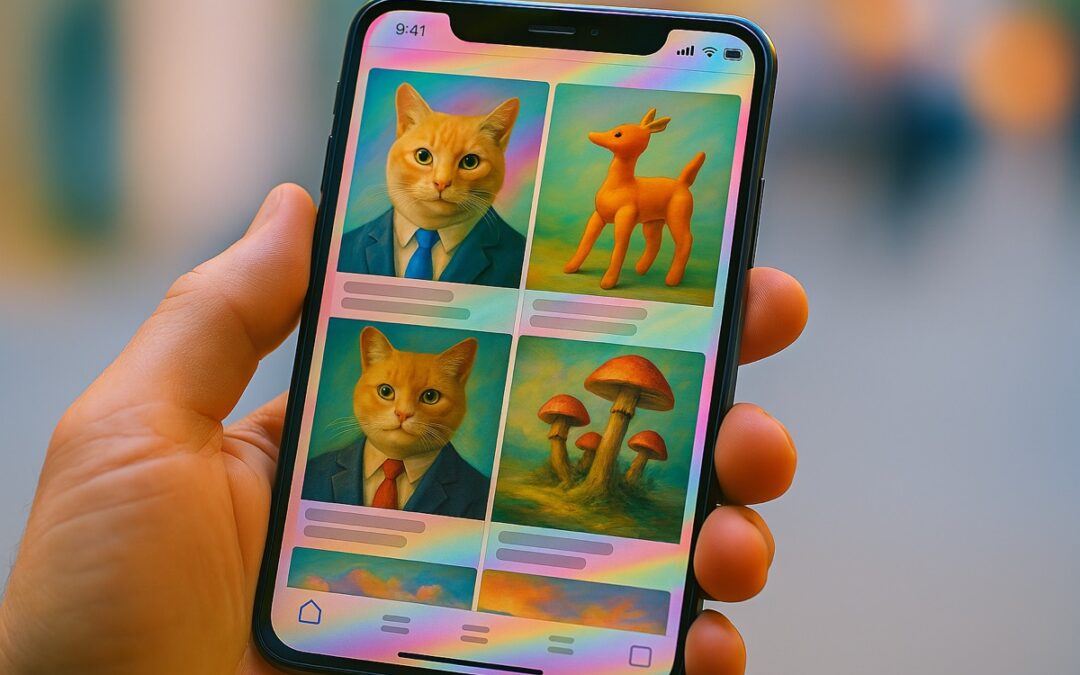Slop will be invading social networks in 2025. Find out why this scourge of mediocre AI images worries Internet users, and how to protect yourself effectively.
Imagine opening your favorite app and being assaulted by an avalanche of grotesque, poorly finished, often absurd images. Deformed faces, improbable sculptures made of vegetables, or recipes worthy of a failed experiment. You've probably come across these images before, but did you know they have a name? It's called "slop". In 2025, slop has become a veritable scourge of social networks, flooding our newsfeeds with low-quality AI content. Slop is no longer just a marginal curiosity: it's everywhere, and its consequences are far more serious than we might imagine.
Slop: a flood of AI images disfiguring the Internet
Slop is the most visible manifestation of the uncontrolled proliferation of generative artificial intelligence. Behind the word "slop", which conjures up a vile, mass-produced mush, lies an alarming digital reality. Slop is defined as the deluge of images or content generated automatically by AI, with no concern for veracity, quality or aesthetics. On PinterestFor example, up to 70 % of images are derived from slop, according to a survey by the Figaro recently.
Slop is everywhere. Facebook, TikTokInstagram, X (ex-Twitter), no social network is spared. The slop attracts users by its unusual, funny or simply absurd nature. But behind the slop's apparent harmlessness lie far less benevolent intentions. The slop exploits human curiosity to trap the least informed users.
Why is slop proliferating so rapidly on social networks?
Slop is a direct consequence of the democratization of artificial intelligence tools. Today, anyone can generate hundreds of images in a matter of seconds via accessible platforms. These images, often poorly produced, become slop once published en masse.
What slop creators are looking for is virality at all costs. The slop is calibrated to be liked, commented on and shared, no matter how grotesque. Worse still, the slop is sometimes used by cybercriminals to test Internet users' reactivity to dubious content, before offering them genuine scams.
The slop thus becomes a misused marketing lever. It drowns authentic publications under a tsunami of AI mediocrity, making verified content difficult to access. Slop threatens the entire digital ecosystem.
Slop and loss of information quality
Slop doesn't just stop at absurd images. It's also infiltrating search engines and publishing platforms. With Google's integration of AIs like Gemini, users are offered "AI Overviews" that summarize their searches. The problem? These summaries are often erroneous, perfectly illustrating the dangers of slop.
This phenomenon is transforming the way we consume information. The slop produces a passive consumption without hindsight. Internet users are easily trapped by an overabundance of content ready to be savored effortlessly, even if it's false or poorly written. Slop impoverishes our digital experience.
The hidden dangers of slop: more than just spam
Slop is sometimes compared to the spam of the 1990s. But slop goes a step further: it disguises itself in a playful and entertaining guise, the better to manipulate Internet users. A breadstick sculpture or a cat in a costume may seem amusing, but behind them lie well-honed strategies to capture your attention and steer your behavior.
Online sales platforms are not spared from the slop. Amazon is teeming with books written entirely by AIs and riddled with errors. Thanks to recommendation algorithms, these slop books can even appear ahead of real publications, relegating the work of human authors to the background.
How to spot and protect against slop
The first tip for detecting slop is to look closely at the details of the images. Experts recommend staring at the pupils and eyes of characters. Slop still struggles to reproduce these anatomical subtleties. Also, always check the source of the image or content. A well-known journalist or media outlet has too much to lose to broadcast slop.
Another essential recommendation: cross-reference information. If a piece of content seems dubious, research it on several platforms before giving it any credence. Finally, educate those around you. Slop often exploits the most vulnerable users, especially those less familiar with new technologies.
Our opinion
Slop is much more than a passing fad on social networks. In 2025, slop is becoming a digital plague, polluting our news feeds, drowning out verified information and undermining our critical thinking. We urgently need to make Internet users aware of its dangers, and learn how to spot slop before it irreparably distorts our relationship with the digital world.
Platforms also have a role to play in curbing the spread of slop. By better filtering AI content and promoting authentic human creations, they can help clean up our online experience.
At ValueYourNetworkAs experts in influencer marketing since 2016, we keep a close eye on the evolution of these digital trends. Our dozens of successful campaigns on social networks enable us to support our customers in the face of these new challenges. Let's stay vigilant together and continue to prioritize authenticity in the digital jungle.

